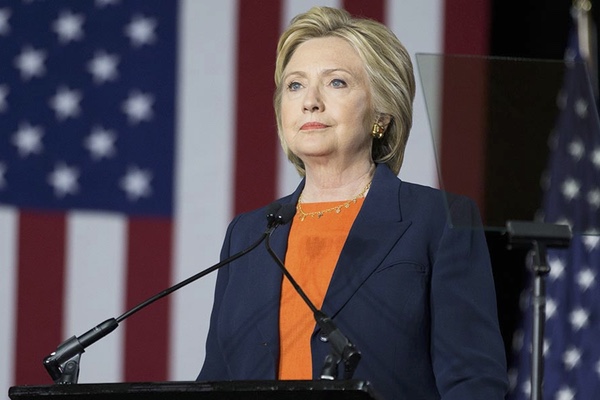Was Hillary the Wrong Candidate Given Her High Unfavorable Numbers?

The answer is no. Any Democrat would have been slimed.
Some Democrats are now feeling buyer’s remorse after seeing Hillary Clinton face withering attacks. They wonder if a more popular Democrat could have discovered an easier path to victory against a deeply flawed candidate like Donald Trump. But in view of Hillary Clinton’s shifting fortunes over recent decades, it seems unlikely that some other Democrat could have finished the presidential campaign with a squeaky-clean image.
Hillary Clinton was generally popular until she announced her intention to compete in the 2016 presidential race. During two decades of public life up until the time she left the office of Secretary of State in early 2013, Hillary Clinton frequently ranked in national surveys as America’s most admired woman. Her strong disapproval ratings this year demonstrate, to a large degree, the potential of partisan politics to arouse doubts in the minds of voters. In today’s cutthroat political environment just about any Democratic presidential candidate would appear bruised and battered after facing vilification on the campaign trail.
A broad historical view of Hillary Clinton’s climbs and falls in opinion polls suggests that much, but certainly not all, of her recent decline has been influenced by political rhetoric that stirred feelings of distrust. Many factors influence a politicians’ popularity, of course, including statements, policies, and actions. Clinton’s gains and losses in surveys were not solely related to attitude—shaping tactics of the political opposition. Hillary Clinton lost ground when news came to light about emails and questions arose about practices at the Clinton Foundation. Nevertheless, the timing of Clinton’s shifts in popularity over recent years suggests that political assaults played a role in moving perceptions to the down side.
From 1993 until the end of last year, Hillary Clinton often ranked first in the Gallup organization’s annual survey concerning admired woman. Gallup asked, “What woman that you have heard or read about, living today in any part of the world do you admire most?” Hillary Clinton placed first in 1993 and she appeared first several times over the next decade, surrendering the top spot a few times to Mother Teresa and Laura Bush. Between 2002 and 2015, Hillary Clinton came in first every year.
Evidence of Mrs. Clinton’s overall popularity before this year’s campaign appeared in an ABC News/Washington Post poll. The survey asked respondents if they had a favorable or unfavorable impression of Hillary Clinton. In 2013 Mrs. Clinton enjoyed a very high approval rating of 67%. She had not announced her candidacy for president at that time. Secretary Clinton’s approval ratings began to drop significantly after she announced in April, 2015 that she intended to run for president. At that point she became a primary target of the opposition.
On August 31, 2016 the Washington Post’s headline identified the severity of her slide in the polls, reporting, “A Record Number of Americans Now Dislike Hillary Clinton.” Among registered voters, Hillary Clinton’s disapproval score was almost equal to Donald Trump’s unimpressive numbers. In late August, 2016 Clinton had a 59% unfavorable rating. Trump’s unfavorable number was only a point higher at 60%.
Years after this presidential election, scholars will examine facts that emerged before the vote of November 8, 2016 in an effort to understand how and why the former Secretary of State’s public image quickly turned negative, especially in 2016. Secretary Clinton stumbled at times during the campaign. She had difficulty answering questions about her private email addresses and server, and her statement at a fundraiser in which she characterized half of Donald Trump’s supporters as a “basket of deplorables” provided ammunition for her critics.
But Hillary Clinton’s slips during the campaign were not severe. Much of the evidence presented against her that supposedly demonstrated untrustworthiness lacked substance. Republicans often invoked old charges that had not held up, such complaints about Clinton’s handling of the Benghazi tragedy in Libya. Filmmaker Michael Moore communicated disdain for those feeble accusations on October 28 in an appearance on Bill Maher’s television show. When Rick Lazio, Hillary Clinton’s opponent in the New York senate race of 2000, referred to Clinton as “a scandal factory” and complained that Mrs. Clinton had been involved in “cattle futures,” Moore responded sarcastically, “I withdraw my support of Hillary Clinton. I forgot about the cattle futures.”
Ironically, President Barack Obama seems to be a beneficiary of Hillary Clinton’s difficulties. Until this year, Obama was suffering from low ratings for his job as President. On numerous occasions during his first seven years in the White House Obama’s approval score fell into the low 40% level. One of the President’s steepest drops (to 40%) occurred in early November, 2014. That was a time of congressional elections, when Republicans attempted to link Democratic candidates to the generally unpopular President. Obama did not enjoy a sustained climb out of his poor standing until February, 2016, and since July of this year his approval has consistently scored above 50%. Perhaps some of Obama’s statements and policies helped to boost his rating in 2016, but the President did not achieve any extraordinary legislative breakthroughs this year. His improved position seems attributable, in part, to a decline in criticism aimed specifically at him. This year the GOP has concentrated its political weapons on Hillary Clinton.
If Barack Obama were running this year instead of Hillary Clinton, voters would be hearing many more claims about Obama’s supposedly flawed and failed leadership. Whoever emerged as the Democrat’s presidential candidate in 2016, that individual was likely to be demonized in the warlike environment of American politics.